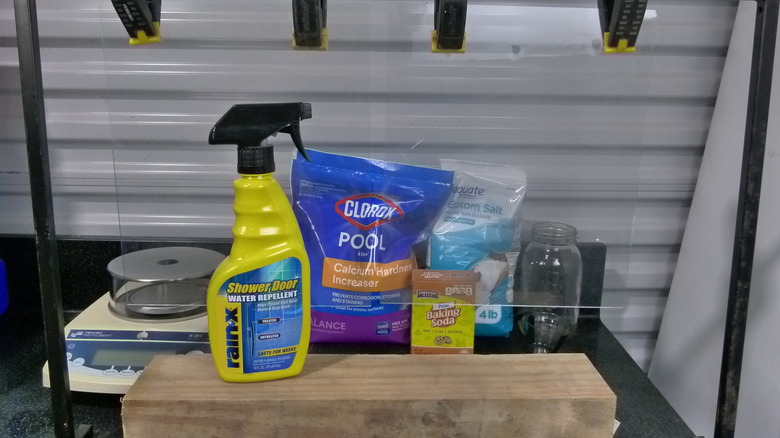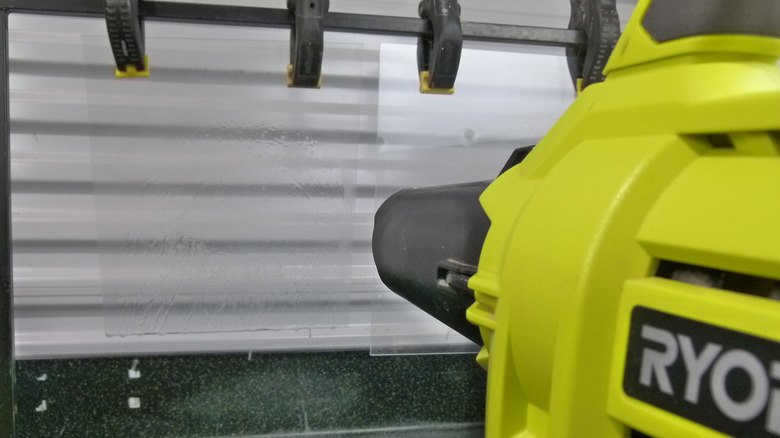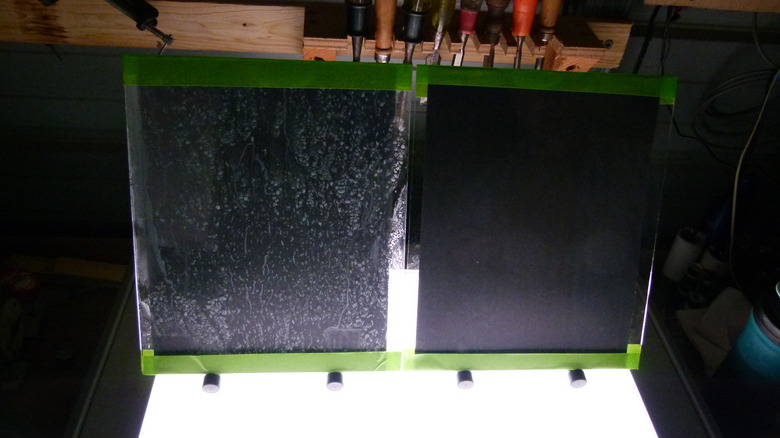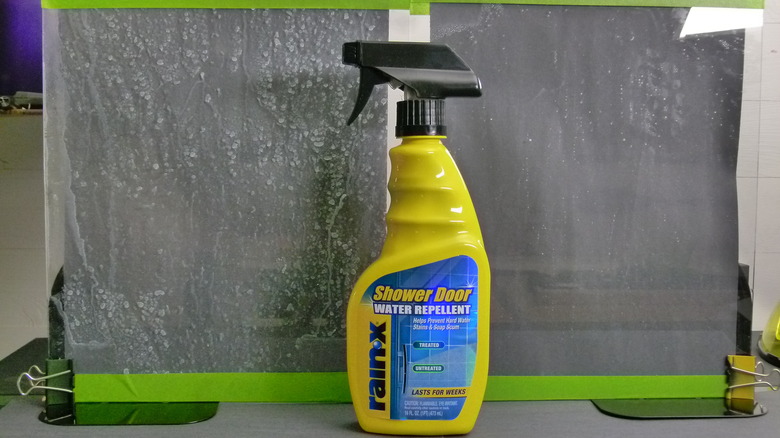We Tested Rain-X Shower Door Water Repellent Against Hard Water With Clear Results
While some people are singing in the shower, others are peering at their glass shower doors and wondering how to keep them clean. There are several factors that make this difficult. First, if you have even slightly hard water — the cause of unsightly mineral deposit stains in your sink and shower — those doors are pelted with it nonstop during most showers, and it inevitably leaves stains behind. Soap, and a bit of everything soap is designed to strip off our bodies, hits the doors, too. Worst of all, just about anything is going to show up on the clear glass. Wouldn't it be nice to treat the doors with a product like Rain-X the way you treat your car windows so that everything just rolls off? This is exactly what Rain-X Shower Door Water Repellent claims to do.
Hard water, soap scum, and whatever your kids are covered with — could that possibly be dog fur and pine sap? — don't seem like they'll be as simple to repel as rainwater. These are elements that your windshield simply doesn't have to cope with. So, I decided to try the Rain-X product specifically for shower doors to see if it lived up to the hype. Specifically, I wanted to test the claim that it "helps prevent hard water stains, soap scum, and grime build up" on glass.
Creating the proper setup
After kicking ideas around for a while, I decided that the things to test were water repellency — it's right there in the name, after all — and the ability of Rain-X Shower Door Water Repellent to prevent hard water stains. While soap scum is pretty easy to come by, hard water is a bit more complicated if you don't naturally have it flowing from your taps. And, if you think hard water might be challenging to produce if you don't have any handy, try testing glass shower doors when you don't have those, either. What I ultimately devised was a way to create hard water and a test that continuously fogged hard water onto two plates of 10-by-12-inch glass from Lowes.
The hard water itself was made by adding sodium bicarbonate, calcium chloride, and magnesium sulfate to water, following a tutorial from Sciencing to produce two liters of supersaturated hard water. (I used tap water rather than distilled water because, well, the point of the whole thing was to test tap water.) This concoction was filtered to remove suspended solids and then applied, using a fogger, to two pieces of glass — one treated with Rain-X and one untreated. Both had been cleaned with carburetor cleaner beforehand to remove any contaminants that might interfere with the test. After doing some reading on the topic of surface tension, I also decided to photograph water droplets on the two surfaces. You probably can't see the problems I was about to face, and neither could I.
Capturing the results
Actually, I could see just fine as the experiment began, but photographing was a different matter. It turns out that photographing clear glass in order to clearly show stains and imperfections isn't the easiest thing to do, and photographing water droplets was a whole other level of "this ain't workin'." Photographing glass was a learning experience, while photographing droplets in profile turned out to be a frustrating experience. Most glass photography is meant to capture some reflections to define the shape of, for example, glassware. Any reflections at all made it difficult to show my results. In the end, I shot the glass on a light table with a black background and no other lighting in the room.
For the close-up shots of water droplets, I tried to use a microscope with the ability to save images. Because of the orientations of the microscope and the droplets, it was impossible to get a photo that would allow me to accurately measure the angle where the glass and water drops intersected. This is how wet-ability is measured, I learned. As wet-ability increases, contact with the surface is maximized and more deposits should be left behind by evaporation. Less wet-ability equals more surface tension. Rain-X's claim that this product "causes water to bead and slide off on [sic] glass surfaces," essentially claiming a behavior equivalent to higher surface tension as well, so I didn't pursue the droplet measurement further.
Rain-X Shower Door Water Repellent repels water on shower doors
The results were surprisingly clear, as seen in the accompanying photographs. The untreated glass was definitely more prone to show hard water stains after repeated fogging with hard water followed by drying with a fan to speed evaporation. The Rain-X did exactly what it claims — it made the water bead up and roll off. The water solution was more saturated with the minerals that cause hard water than any household tap water would be, but since water hardness increases surface tension, this seemed likely to benefit the untreated glass the most (water already readily beads up and runs off of the Rain-X-treated glass).
I can't say absolutely that it would have the same effect on soap scum, but all the evidence indicates that it would. Hard water stains surfaces by leaving minerals behind after evaporation, and the same is true of soap scum, a dehydrated mixture of hard water minerals, soap, dirt, skin oils, etc. left behind to build up in a bath or shower. I'm confident that Rain-X Shower Door Water Repellent will markedly reduce hard water and soap scum stains on shower doors under any normal circumstance. There are simple ways to test for hard water if you think you have it, but it wouldn't hurt to use Rain-X as a preventative measure since it also reduces soap scum. Before your first application, try using rubbing alcohol to get your doors streak-free and give the Rain-X a clean starting point.




